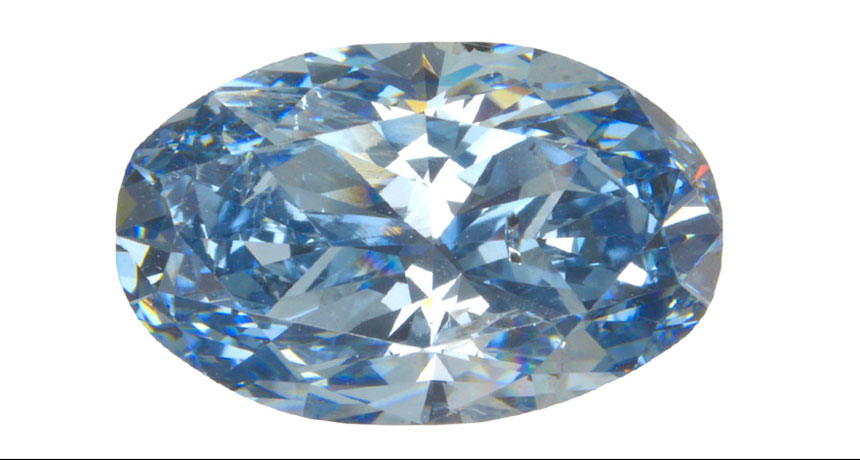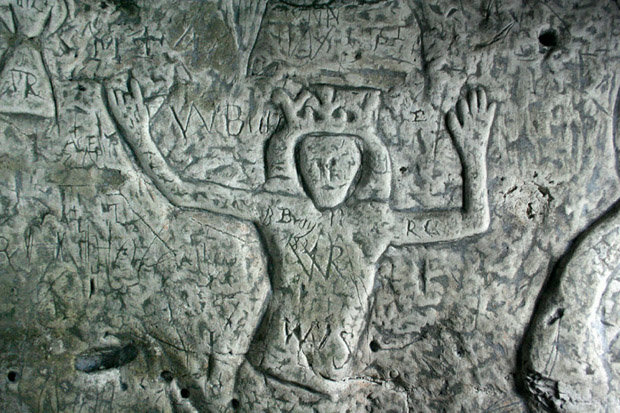
Rare blue diamonds may be Earth’s deepest secret.
Diamonds have a lot going on. Besides their sought-after clarity, extreme hardness, and entanglement in civil wars, diamonds tell unique geologic stories. Contrary to the convenient idea that they are born from a magical transformation of compressed coal, diamonds actually form deep within the Earth and blast to the surface in unusually rapid volcanic eruptions.
What a jeweler might call an “impurity” in a diamond, a geologist calls an “inclusion.” These bits of other minerals trapped inside can tell you where that diamond came from and what it was like down there. In a new study of rare blue diamonds (like the famous Hope Diamond), a team led by Evan Smith of the Gemological Institute of America discovered that they appear to form at exceptional depths—yet are tinted blue by boron from ancient oceans.
Only about 0.02 percent of diamonds are blue, making them a rarity among rarities. They’ve been found around the world, though, in volcanic deposits as old as 1.2 billion years and as young as 90 million. The weird thing about them is that the boron that turns them blue is exceedingly rare down in the Earth’s mantle and much more common in the Earth’s crust.
To figure out where a blue diamond formed, you have to look at the minerals in its “inclusions.” Obviously, diamonds are expensive—and a number of faceted gems were actually analyzed for this study—so crushing them up to feed them into a machine is off the menu. That leaves non-destructive options like X-rays and low-power lasers to identify minerals.
The results showed that blue diamonds do not contain the common set of minerals seen inside diamonds that form just below continental plates. The deeper a diamond’s source, the harder you have to work to figure out what’s going on. That’s because the minerals that exist deeper in the Earth destabilize as the diamond rises up toward the surface (and experiences lower pressures)—the original mineral morphs into a collection of other minerals.
Just as you can guess that a jar of separated oil, egg, and vinegar was once mayonnaise, you can reconstruct the diamond’s initial state. Using that principle, the minerals in these blue diamonds point to an origin in the lower mantle—as deep as diamonds get, basically. And a number of other observations support that conclusion. As an ascending diamond depressurizes, the inclusions have trouble expanding inside their diamond cage, leading to tiny telltale fractures and even what looks like an exploding “spray” of tiny mineral bits.
In fact, mineral inclusions never get to completely depressurize to surface conditions, and this “remnant pressure” can also be measured by a laser instrument. This, too, indicated that these diamonds must have come from deep within the mantle.
And finally, microscopic envelopes of methane were even detected surrounding inclusions—that’s a product of hydrogen released by inclusion minerals as they depressurized, which then reacted with the carbon of the diamond.
With their extreme depth established, the fact that blue diamonds seem to be colored by an element from the surface’s crust becomes even more interesting. CT-scan-like images of the Earth’s interior show us that subducted tectonic plates sink all the way down to the bottom of the mantle (eventually), effectively recycling that rock. Chemical evidence of that process is sparse, though, because most elements that are recognizable as coming from the Earth’s crust tend to get cooked out of the subducting plate before it gets very deep.
In addition to the presence of the boron, some of the mineral inclusions point to basalt—which makes up seafloor tectonic plates—being chemically involved in these diamonds’ formation. The researchers think this all paints a consistent picture. Seafloor plates get subducted, carrying boron down into the deep mantle where they donate some to the cause of making blue diamonds. The diamonds are transported upward by the slow movement of the mantle and are eventually launched up to the surface in an eruption.
That would mean that blue diamonds are sparkling evidence of elemental recycling by plate tectonics, including the transportation of water (bound up in minerals) down to the lower mantle. And since the boron likely got into the seafloor plates through hydrothermal reactions with seawater, the diamonds’ color is—coincidentally but truthfully—an oceanic blue.













